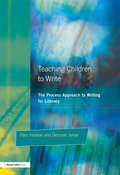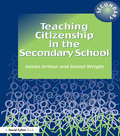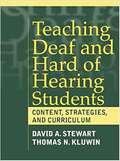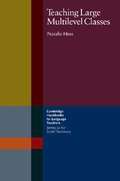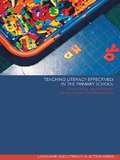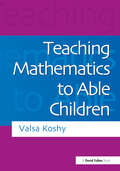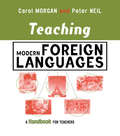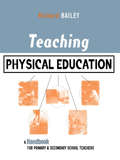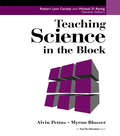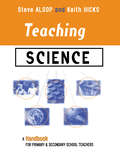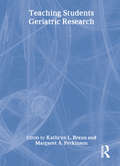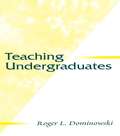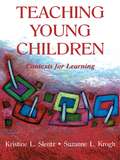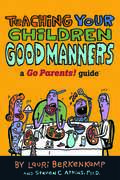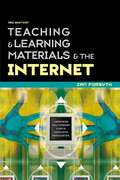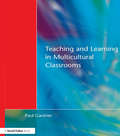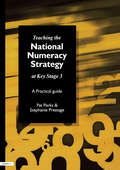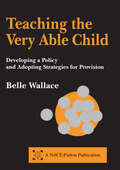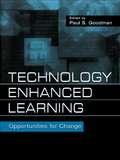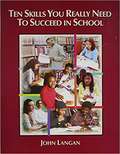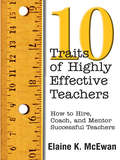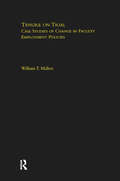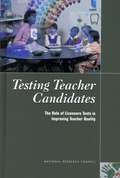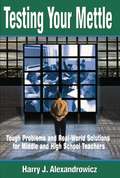- Table View
- List View
Teaching Children to Write
by Deborah Jones Pam HodsonA recent OFSTED report identified the fact that, while many teachers were confident about their teaching of reading, 'too many are neglecting the teaching of writing in the Literacy Hour'. This book, building on the process approach adopted by both National Literacy Strategy and National Curriculum 2000, addresses the fundamental question, 'How do you teach writing?' / Pam Hodson and Deborah Jones provide teachers with, practical strategies, support through a clear and concise rationale, and explicit explanation of the different stages of the writing process. / This theoretical perspective is the basis of differentiated writing frames provided for the classroom use of teachers and pupils alike. Thus invaluable support is given to teachers and student teachers of writing across a wide range of genres throughout Reception, Key Stages 1 and 2, and in the early secondary years.
Teaching Citizenship in the Secondary School
by James Arthur Daniel WrightThis text supports student teachers, NQTs and practitioners in implementing the Citizenship Order in secondary schools - to be introduced in September 2002. With a practical, clear focus, the authors provide an intellectual challenge; argument and evidence to help the reader come to an informed view on the complex and controversial issues in each chapter; well-focused examples; and strategies for use in the classroom.
Teaching Deaf And Hard Of Hearing Students: Content, Strategies, And Curriculum
by David A. Stewart Thomas N. KluwinThis highly practical reference for both pre-service and in-service teachers of the deaf and hard of hearing covers methods of teaching and other issues related to the teaching of deaf students. Teaching Deaf and Hard of Hearing Students takes a practical look at the challenges of teaching subject matter to deaf children. The book gives suggestions about what teachers can do in the classroom that will make a positive difference in how their deaf students learn. It emphasizes providing teachers with a framework to design instructions that meet the educational needs of their deaf students. The principles upon which instructional planning proceeds are applicable to deaf students at all grade levels; thus, the book is suitable for teachers at the elementary through high school levels. These principles are diverse but revolve around four central themes: 1) Creating authentic experiences; 2) Integrating vocabulary development; 3) Creating opportunities for self-expression; and 4) Providing deaf role models. When applicable, distinctions are made between the various instructionalroles of teachers in self-contained classrooms, resource room teachers, and itinerant teachers, as well as general education teachers who have deaf students in their classrooms. Issues relating to diversity, discipline, and disabilities are reviewed from a pragmatic perspective. Ideas are then presented about how teachers can address these issues through instruction. Finally, strategies are provided for involving the family in the education of their deaf children, including exercises for increasing family awareness of the learning challenges their deaf children face. Practical ideas about how teachers can empower parents in the learning process are featured. Educators of deaf and hard of hearing students.
Teaching Large Multilevel Classes
by Penny Ur Natalie HessThis book provides practical advice for teachers who work with large, mixed-ability classes. It offers a wide variety of activities to develop student motivation, interest, participation and responsibility.
Teaching Literacy Effectively in the Primary School (Language and Literacy in Action)
by Jane Medwell David Wray Louise Poulson Richard FoxThis book discusses the implications arising from the authors' research into what constitutes an effective teacher of literacy. They have been able to identify what effective teachers know, understand and do which enable them to put effective teaching of literacy into practice in the primary phase. By identifying the strategies used by these teachers, the authors show how these can be applied by other primary teachers to improve their teaching of literacy.
Teaching Mathematics to Able Children
by Valsa KoshyThis book enables teachers to effectively meet the needs of their most able mathematicians. Using a tried and tested set of principles developed and used by The Able Children's Education Unit at Brunel University, the author demonstrates how to: identify high mathematical ability in a pupil, plan suitably challenging activities and teach them most effectively within the existing National Numeracy framework, make the most of the classroom resources available, including ICT and external agencies, implement strategies for differentiation, illustrated with real-life classroom examples. Accessible in style and featuring practical case studies throughout, this book will give teachers and student teachers the confidence and knowledge to effectively challenge and develop the skills of the most able mathematician.
Teaching Modern Foreign Languages: A Handbook for Teachers
by Carol Morgan Peter NeilDesigned for all trainee and newly qualified teachers, teacher trainers and mentors, this volume provides a contemporary handbook for the teaching of modern foreign languages, covering Key Stages 2, 3 and 4 in line with current DfEE and TTA guidelines.
Teaching Physical Education: A Handbook for Primary and Secondary School Teachers
by Richard BaileyDesigned for all trainee and newly qualified teachers, teacher trainers and mentors, this volume provides a contemporary handbook for the teaching of physical education, covering Key Stages 2, 3 and 4 in line with current DfEE and TTA guidelines.
Teaching Science in the Block
by Alvin Pettus Myron BlosserThis book provides detailed instructional strategies, sample lesson plans, and sample assessments to help science teachers make the best us of the additional time available in a block schedule.
Teaching Science: A Handbook for Primary and Secondary School Teachers (Kogan Page Teaching Ser. #29)
by Steven Alsop Keith HicksDesigned for all trainee and newly qualified teachers, teacher trainers and mentors, this volume provides a contemporary handbook for the teaching of science, covering Key Stages 2, 3 and 4 in line with current DfEE and TTA guidelines.
Teaching Students Geriatric Research
by Kathryn Braun Margaret A PerkinsonTeach your students essential skills in conducting research, building collaborative partnerships, and working with clients and caregivers!This important book provides health care educators with information, examples, and suggestions to help teach students appropriate research techniques amidst a growing demand for evidence-based practices. Offering two effective and efficient methods, the apprenticeship model and the partnership model, Teaching Students Geriatric Research will show you how to incorporate these research fundamentals in an already heavy courseload. By providing conceptual rationales and guidelines for these models and directions on how to use them, this thorough guide will assist you in enhancing research training for your students and preparing them for a career in the health professional field. Through this unique book, you will find clear descriptions and illustrations of the apprenticeship and partnership models of research to help you provide your students with a hands-on leaning experience. Teaching Students Geriatric Research provides you with guidelines and suggestions on how to successfully use both models of training described in this book, such as: exploring guidelines for training students and incorporating them into ongoing research discussing students’reflections on the relevance of research training for professional development based on their own experiences as research apprentices discovering the various skills that students can develop as a result of their involvement in research training apprenticeships finding that the skills students learn through the research process will benefit their future clinical practice and client intervention realizing how students’research apprenticeship can sensitize them to family caregiving issues and problems alerting students to the potential role of occupational therapists in enhancing occupational performance by maximizing fit between the caregiver, environment, and roles or occupation by matching the personality of the caregiver with their occupation examining useful and concrete suggestions on developing fruitful partnerships between faculty, students, and service providers, as well as discussing the factors involved in the successes of collaboration from an already existing collaboration between rehabilitation hospital and a major universityWith Teaching Students Geriatric Research, you will discover the potential in each approach for improving the research training among students in your academic situation. You will gain valuable insight from student perspectives on what they learned as well as proven suggestions from faculty researchers’perspective to provide you with a complete overview of how to enhance and enrich the academic experiences of your students.
Teaching Undergraduates (Educational Psychology Series)
by Roger L. DominowskiThis practical guide is designed to help college teachers plan their undergraduate courses and deliver high-quality instruction. The book's theme is that teaching is a creative, decision-making, idea-testing enterprise whose purpose is to facilitate student learning in all of its facets. Its goal is to help instructors understand the multiple kinds of learning taking place in their courses so that they can select, devise, evaluate, and modify teaching techniques to improve their effectiveness. Based on research on human learning, memory, thinking, and problem solving, as well as studies of teaching and less-formal reports of teaching practices, the book offers concrete advice about all aspects of college teaching. *Part I is devoted to course planning. It outlines the many decisions instructors face in defining a course as their own and discusses the larger issues that shape a course and constrain some specific choices. Selecting course content, choosing learning goals, deciding how to pace a course, and scheduling tests are some of these issues. A workable timetable for preparing a course is included. *Part II is a mini-course on human learning, memory, and thinking. It provides the conceptual foundation for making teaching decisions, for selecting instructional strategies, and especially for inventing new techniques that might particularly fit a specific course. *Part III deals with the "nitty-gritty" of college teaching, including how to choose a textbook; lecturing and conducting classroom discussions; types and purposes of writing assignments, and how to structure and evaluate them; dealing with plagiarism; strengths and weaknesses of different types of tests, the relation of tests to learning goals, and guidelines for constructing good tests; and grading systems. *Part IV addresses professional and ethical issues of importance and consequence to instructors. New college instructors, more experienced faculty who would like to reflect on their teaching practices and consider making some changes, and teaching assistants will all find this book relevant and useful.
Teaching Young Children: Contexts for Learning
by Suzanne L. Krogh Kristine SlentzUsing play as the method against which all others are compared, this book presents the strengths and weaknesses of different models of teaching, examines various methods of guiding young children's behavior, and shows how to create and maintain a positive learning environment. Finally, it discusses how to work as a team member in ECE settings.
Teaching Your Children Good Manners (a Go Parents! Guide®)
by Lauri Berkenkamp Steven C. AtkinsFor parents everywhere who have had lovely family dinners ruined by misbehaving children, help is at hand. This guide provides a humorous, hands-on, parent-friendly approach to teaching children of all ages good manners in a wide variety of social situations, from accepting gifts graciously to which foods are OK to eat with fingers. Each chapter tackles a different situation, gives a brief outline of what manners are appropriate for it, and offers advice on how to teach and reinforce them to children of different ages. There is also a "What to Expect" chart broken down by age, and a Q & A section devoted to questions concerning children and manners.
Teaching and Learning Materials and the Internet
by Forsyth, IanAn exploration of the teaching and learning material available on the Internet. It provides information on the appropriate way to handle and use the Internet as a delivery tool in education, and considers the implications this will have on the role and relationship of the teacher and learner.
Teaching and Learning in Multicultural Classrooms
by Paul GardnerTeachers and student teachers wishing to gain a better understanding of the theory and practice of educating children in multicultural classrooms will find this book invaluable. By integrating the theory and practice of EAL teaching and multicultural education, within an equal opportunities framework, the author clearly demonstrates how the guidance can be implemented directly into the classroom.
Teaching the National Strategy at Key Stage 3: A Practical Guide
by Pat Perks Stephanie PrestageNational Numeracy Strategy (NNS) for Key Stage 3 will be introduced into Secondary Schools in September 2001. The NNS document: Framework for Teaching Mathematics in Years 7 to 9, is based on the National Curriculum, but offers a very different interpretation of some of the expected learning outcomes for year 7 to 9. This practical book, interprets and explains the document for busy practitioners, spells out the expectations of the framework and offers guidance on how to fulfil these, describes and explains the types of teaching methods for maximising students' learning, and includes many practical ideas for classroom activities within the framework of the NNS.
Teaching the Very Able Child: Developing a Policy and Adopting Strategies for Provision
by Belle WallaceThis introduction to the field of teaching the very able child provides practical help on meeting their needs within the mainstream school, and advice on formulating and developing effective whole-school policy. This book examines strategies for identification and provision which are in line with current government policy. It questions the definitions of the terms 'gifted' and 'very able'. The author encourages heads, teachers and governors to discuss and adopt principles which suit the very able pupils' specific needs. The book demonstrates how the whole-school policy can be put into effective practice. It also provides guidelines for checking that day-to-day lessons have sufficient challenge for the very able child. The author, who is highly experienced in this area of education, has carefully selected relevant information which schools can use as a basis for their decision making, and offers an extended reading list for those wishing to read the topic in greater depth. The book offers a comprehensive and reliable overview of educating very able children.
Technology Enhanced Learning: Opportunities for Change
by Paul S. GoodmanThis book focuses on how technology may create new learning environments and enhance basic learning processes. The book identifies and informs some of the strategic decisions involved in designing and implementing new technology to enhance learning. It also examines specific learning applications of TEL in order to understand the context of different learning environments, as well as some of the critical lessons learned in designing these environments. Mixing both conceptual perspectives and actual case experiences should create different learning opportunities for the reader. Technology Enhanced Learning is divided into two parts. Part I deals with strategic issues, such as trends in technology, implications for educational systems, designing infrastructure, and learning environments. Part II looks at specific cases of new learning environments to learn about strategy, infrastructure, impact assessment, and change in TEL learning environments.
Technology for All Assistive Technology in the Classroom
by Overbrook School for the BlindAn easy-to-read, field tested resource for all schools and colleges that need assistive technology in the classroom.
Ten Skills You Really Need to Succeed in School
by John LanganA guidebook to the essential skills necessary for students to make the transition from high school to college.
Ten Traits of Highly Effective Teachers: How to Hire, Coach, and Mentor Successful Teachers
by Elaine K. McEwan-AdkinsThis user-friendly resource for administrators and teachers explores the ten characteristics that lead to success in the classroom, increased school morale, satisfied parents and eager, high-achieving students.
Tenure on Trial: Case Studies of Change in Faculty Appointment Policies (RoutledgeFalmer Studies in Higher Education)
by William MallonThis book examines how and why colleges abolish or institute tenure by profiling four colleges: two that moved from tenure to term contracts and two that moved from contracts to tenure.
Testing Teacher Candidates: THE ROLE OF LICENSURE TESTS IN IMPROVING TEACHER QUALITY
by National Research CouncilAmericans have adopted a reform agenda for their schools that calls for excellence in teaching and learning. School officials across the nation are hard at work targeting instruction at high levels for all students. Gaps remain, however, between the nation’s educational aspirations and student achievement. To address these gaps, policy makers have recently focused on the qualifications of teachers and the preparation of teacher candidates. This book examines the appropriateness and technical quality of teacher licensure tests currently in use, evaluates the merits of using licensure test results to hold states and institutions of higher education accountable for the quality of teacher preparation and licensure, and suggests alternatives for developing and assessing beginning teacher competence. Teaching is a complex activity. Definitions of quality teaching have changed and will continue to change over time as society’s values change. This book provides policy makers, teacher testers, and teacher educators with advice on how to use current tests to assess teacher candidates and evaluate teacher preparation, ensuring that America’s youth are being taught by the most qualified candidates.
Testing Your Mettle: Tough Problems and Real-World Solutions for Middle and High School Teachers
by Harry J. AlexandrowiczIn this straightforward guide to what really happens in classrooms and hallways, veteran teacher and administrator Harry J. Alexandrowicz makes “reality training” available to both novice and experienced teachers. Alexandrowicz draws from his 28 years’ experience in schools to help prepare teachers to handle the inevitable legal, philosophical, and common-sense challenges they face every day. These challenges are presented as brief vignettes followed by four possible solutions with space for the educators to write their proposed actions, followed by sections on what actually happened, and why. The kinds of scenarios you will learn about include: A parent threatens you You witness students hazing another student You discover a gun in a student’s locker The school’s best athlete is failing your class You see inappropriate student behavior outside the classroom. This accessible “insider’s” view of the classroom will be an essential resource for teachers, administrators, and parents who want to gain valuable insights into how to handle what really happens in schools today.
